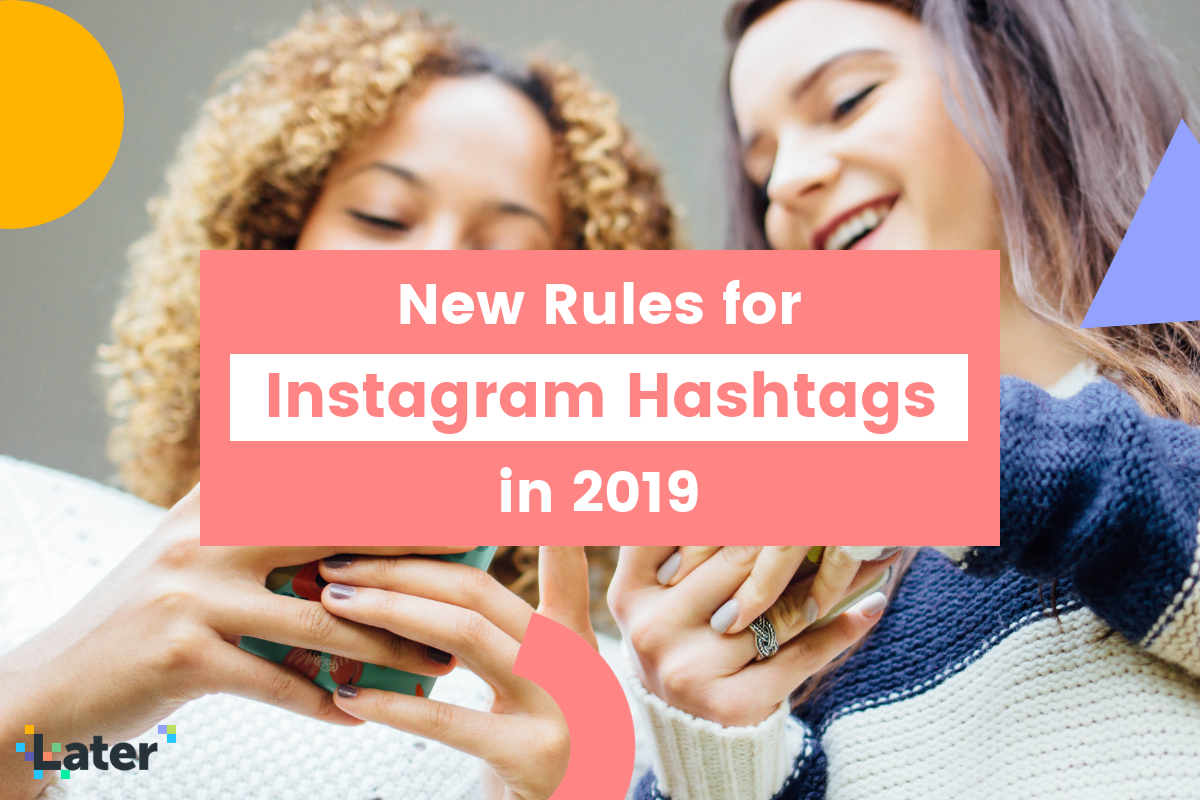
22 Jul New Rules for Instagram Hashtags: How to Find the Right Hashtags for Your Business
The rules for Instagram hashtags have changed.
It’s a brand new year and like almost everything else related to Instagram, best practices that worked in the past just aren’t as effective anymore.
From following hashtags to adding them to your Instagram Stories, we’re showing you all of the new ways that you can use Instagram hashtags to help you grow your brand this year, as well as sharing helpful hashtag tips to ensure that you’re using hashtags strategically to meet your marketing goals!
Here are the new rules for Instagram hashtags and how you can find the right hashtags for your business:
Keeping Your Instagram Hashtags Relevant is More Important Than Ever
Instagram recently rolled out the ability to follow hashtags which means that instead of a user having to search for an Instagram hashtag and scroll through an endless feed to (hopefully) land on your content, your posts could now show up automatically in the feeds of potential new followers.
While Instagram’s algorithm has always favored the use of specific and relevant hashtags, this new feature makes using hashtags that make sense an even bigger deal.
That’s because users now have the power to mark your hashtagged content as something they don’t want to see!
This is how it works.

Once a user is following a specific hashtag and suggested posts begin to show up in their feed, they’ll have the ability to select a new “Don’t Show for This Hashtag” option to mark the content not interesting or not relevant.

While this information is meant to tell the Instagram algorithm what sort of content a user enjoys, having too many of your posts marked in this manner could potentially raise a red flag on your account and negatively affect all of your other content as well.

Switch Up Your Instagram Hashtags to Avoid “Spammy” Behavior
Copying and pasting the exact same list of Instagram hashtags into every single post and call it a day won’t just impact your engagement, but it can also make you look spammy!
The most important thing to keep in mind when deciding what hashtags to use is that you’re being intentional — as in, you’re using hashtags that your target audience is actually searching for and following!
According to Alex Tooby, It’s important to switch up your Instagram hashtags in every post to avoid being “spammy.” It’s also a good idea to avoid gimmicky hashtags such as #likeforlike, and hashtags that have been used over 1M times. While these hashtags might get you a few extra likes, they aren’t going to help you grow a highly engaged, targeted following.

Instead, try looking for ultra-niche community hashtags that are specifically relevant to the content you post. It’s not a bad idea to use Saved Captions to build multiple hashtag lists that are organized by theme or category.
For example, if you’re a business that targets small business owners in the fashion industry, you may have multiple hashtags that you use on different topics.

Some may be specifically for small businesses, while others might be about fashion and ecommerce. The key is to collect and categorize them so that when they are used in a post, you can easily tell which pulls in the most engagement on your post.
And don’t forget to use your branded hashtag whenever it makes sense! The first step to getting other users to share your branded hashtag is to use it yourself.
Watch Alex Tooby chat more about Instagram Stories for small businesses, hashtags and building a strategy for success in this video:
Saving multiple hashtag lists with Later will most definitely save you time, but how do you know that you’re using the right hashtags for your posts in the first place?
We recommend choosing hashtags that describe your account, your business, and your target market.
For example, if you’re a baby food company whose target market is expecting moms and parents with small children, you should use hashtags that describe your product and business, like #babyblends, #freshbabyfood, and #organicbabyfood as well as your own branded campaign hashtags.

You can also hashtags that describe your ideal customer like #babyfoodie, #girlmom, #boymom, and #babyontheway, along with community hashtags for parents like #motherhoodunplugged, #letthembelittle, and #dailyparenting.
Community hashtags are Instagram hashtags that connect like-minded users around a specific subject. They’re a great way to connect with others, improve the searchability of your posts, gain followers, and grow your own community.
Look to industry leaders and other influencers and brands in your niche to find out what community hashtags they’re using so you can add those to your hashtag lists as well!

Use a Third-Party Tool to Find the Right Instagram Hashtags for Your Business
If you still need some help finding niche and industry-specific hashtags then you may want to check out Later’s Hashtag Suggestions feature.
Hashtag Suggestions works by automatically finding relevant hashtags for your posts based on other hashtags that you use.

For example, let’s say you’re posting a photo of a beautiful bedroom to promote your business that sells linens. All you have to do is know one relevant hashtag (like #livesimply), put it into Hashtag Suggestions, hit “Suggest,” and the feature will immediately generate 30 other hashtags, sorted by relevance.
You can then pick and choose which of these hashtags to add you to your post. All you have to do is click “Insert Hashtags” and they’ll be added to the end of your caption.

You can then pick and choose which of these hashtags to add you to your post. All you have to do is click “Insert Hashtags” and they’ll be added to the end of your caption.
How Many Hashtags is the Right Amount of Instagram Hashtags?
There’s a lot of conflicting information out there about how many Instagram hashtags is the “right” amount.
So if you’re wondering how many hashtags you should be using on each post, the jury is still out!
Alex’s advice is to use the maximum number of hashtags allowed by Instagram, which is thirty. While thirty tags may seem like a lot, she says that using the maximum amount of Instagram hashtags gives you more opportunities to be discovered.

We’ve seen all sorts of strategies and ideas on how many hashtags make the difference, but at the end of the day, it’s really up to you. If you can find thirty super relevant hashtags to add to each post, then you should definitely go for it.
However, if you don’t feel comfortable using that many, feel free to opt for less. It’s always okay to experiment with the amount of hashtags you use on a post in the search to finding your hashtag sweet spot.
The most important thing to keep in mind is that you’re being intentional with your hashtag selection and you’re using hashtags that your target audience is searching for and following.

How to Hide Hashtags on Instagram with Later
- Open a scheduled Instagram post in the Later desktop app
- Paste your Instagram hashtags into your caption
- Add a few returns (5-6 should do it) to move your hashtags further down
- Select either “notification” or “auto publish” for publishing
- When you post your photo, Instagram will only reveal the first few lines of your caption so your hashtags will be hidden

Business Profiles Can Track Instagram Hashtag Success with Post Insights
Those who’ve switched to a business profile not only have the ability to check on how their accounts are growing over time with Instagram’s analytics, but they can also analyze how individual posts are performing and compare the specific results from each.
What does this mean for you?
You’ll be able to see exactly how effective your posts are at attracting a new audience, based on impressions from various sources– including your Instagram hashtags! Having access to these insights can help you to continuously optimize your hashtag strategy.
To access this information, select the post you want to get more detailed analytics on and hit View Insights on the bottom left.

Swipe up to see the full page of data for that post, including things like reach, impressions, and interestingly enough — how the people who viewed your post found you.

If you’re on one of Later’s paid plans, you can also use Later’s Hashtag Analytics to track key insights about the hashtags you use, including a breakdown of which hashtags are driving the most likes, comments, impressions, saves, and reach on your Instagram posts.

You can use this data to see which hashtags are driving the most engagement on your posts. Once you find your top performing hashtags, you can use them more often to get even more engagement and traction for your business.
You Can (And Should) Follow Hashtags on Instagram
As previously mentioned, in a big update from 2018, Instagram added the ability to “follow” hashtags, meaning you can now stay up-to-date on various topics (or communities) by following a hashtag related to your interests.
Following a hashtag works just like following a user’s profile. When you find a hashtag you’d like to follow you simply open the hashtag page and tap on the follow button.

For brands and businesses, this opens up a great opportunity to regularly appear in a follower’s feed. For example, if you have a branded hashtag for your business, you can invite your followers to also follow your unique hashtag.
This means that your content could appear twice in a follower’s feed — once as they follow your profile, and once again as they follow the hashtag. It doubles your chances of engagement!
You can also use this new feature to keep a close eye on competitors and even discover potential partners by choosing to follow industry-specific hashtags.
You Can Also Add Instagram Hashtags to Your Instagram Stories
Adding hashtags to your story is a great way to give your content an added chance to be discovered by new audiences. When people search for a hashtag on Instagram, if it’s popular enough, they’ll be able to view active, real-time stories on that hashtag’s page — including your own.
And if they like what they see, they might even tap follow on your profile!

There are two different ways to add hashtags to your stories. One is by using the hashtag sticker (you can only add one hashtag with this method), and the other is by using the text tool and simply typing your hashtags out (you can add up to 10 hashtags using this method).
However, they can also ruin the aesthetic of an Instagram story and look “spammy” if you’re posting a ton on each story.
Add Instagram Hashtags to Your Instagram Bio
Whether you’re promoting an Instagram contest or UGC campaign, including your branded hashtag in your Instagram bio is a fantastic way to drive engagement on your posts!
What’s so great about this feature is that it makes your bio even more functional — you can use hashtags for everything from promoting your Instagram community to highlighting your branded content and announcing your Instagram campaigns.

Including your branded hashtag in your bio is also a great way to get your followers in the habit of posting with it.
All you have to do is include a “#” before any word in your bio and it will automatically become a clickable link that leads visitors to that hashtag.

Using Instagram hashtags strategically is still a great way to connect with customers, find content created about you by your followers, and build long-term relationships with influential partners!
Hopefully, these new rules for using Instagram hashtags have sparked some new ideas that you can begin to implement around your own hashtag strategy!


Sorry, the comment form is closed at this time.